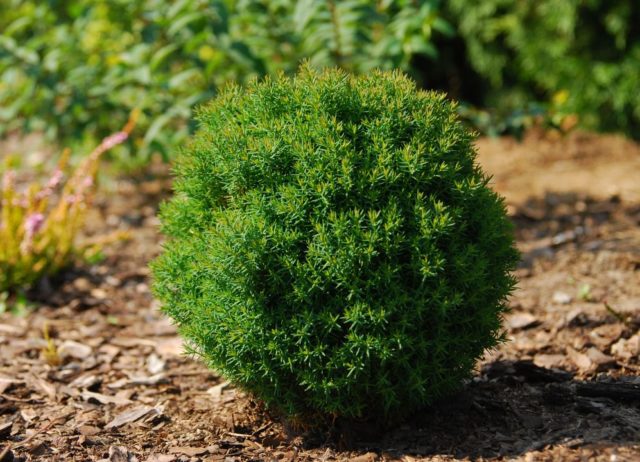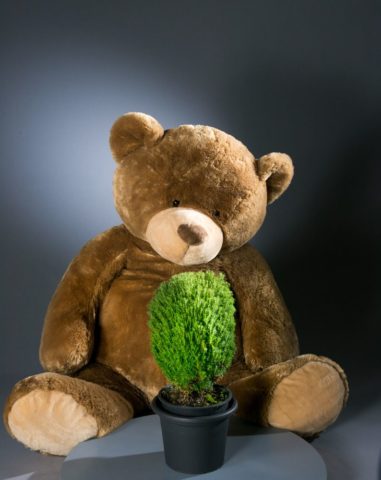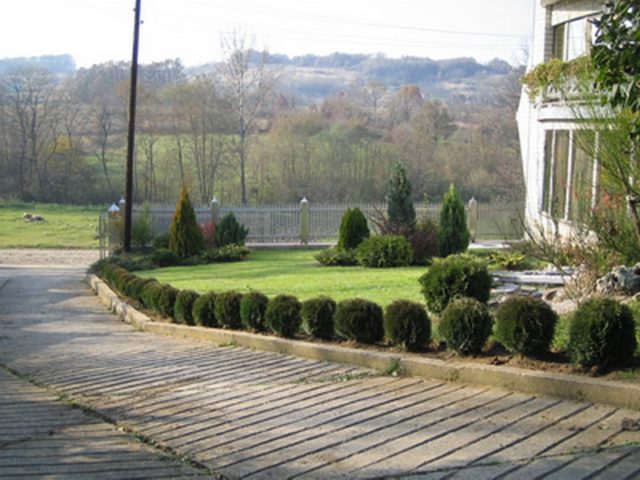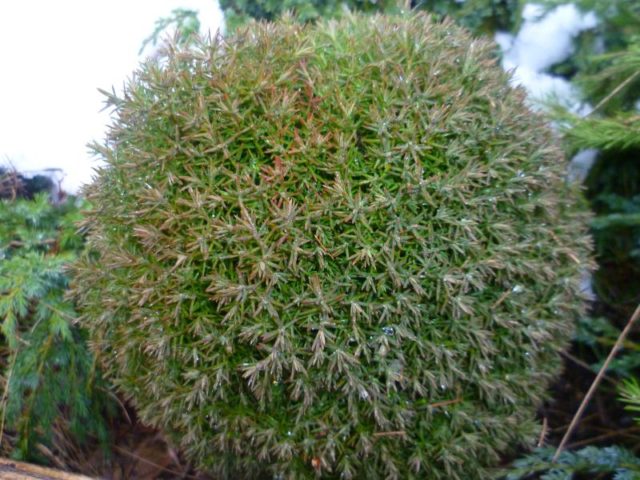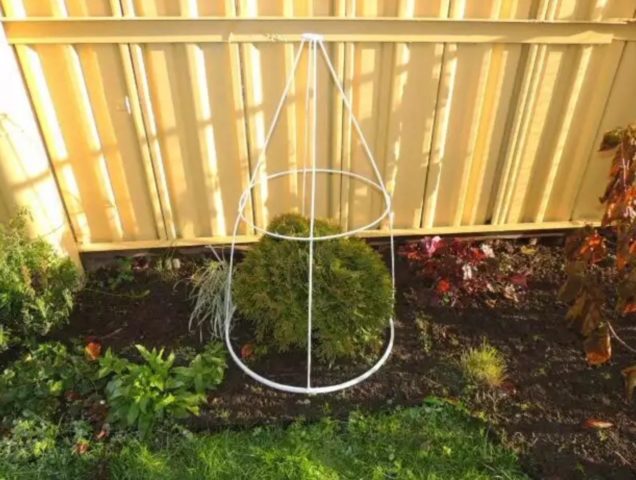Content
Thuja Teddy is an unpretentious undersized variety with evergreen needles, which develops well in the climatic conditions of the middle zone. Having chosen the right place for the location of the plant, if necessary, enrich the substrate and monitor the moderate moisture of the soil. Mature western thuja bushes are winter-hardy and not susceptible to short-term drought.
Description of Western Thuja Teddy
The authors of the variety named the dwarf bush with a cushion-shaped crown "Bear Cub" because of its small size and dense, soft needles. The spherical thuja Teddy retains its miniature size for a long time:
- grows only 25-35 mm per year;
- 3-year-old seedlings, which are sold in nurseries in 3-liter containers, miniature - 10-15 cm in height and width;
- after 10 years, the height of the bush reaches only 30-40 cm, diameter 30-35 cm;
- after 17-20 years of development, the declared size of an adult plant is gaining - 0.5 m.
The root system of the dwarf Teddy variety is located near the surface of the soil, densely branched, requires loose and constantly slightly moist soil. Thin, but densely growing shoots themselves form a rounded, dense crown of the western thuja, usually several centimeters more in width than in height. With age, after 23-25 years, the branches fall apart a little. Soft-needle needles are dense, dark green, not prickly, thanks to which the variety of shrubs from a distance gives the impression of a plush ball. With the cold, the needles become brownish, in the spring they turn green again.
Shade-tolerant Teddy variety requires only 4-5 hours of exposure to the sun, grows well in semi-shady places. In the southern regions, western thuja bushes are grown only in areas with sufficient shading or with constant drip irrigation. The needles do not tolerate dry air well. The plant tolerates several days without watering, but the superficial location of the roots of the species dictates its own conditions for caring for a moisture-loving evergreen bush. Thuja Teddy endures up to - 31-32 ° C, young plants are sheltered for the winter. The shoots of the variety initially form a rounded crown, amenable to topiary cutting.
The use of thuja Teddy in landscape design
The dwarf variety of western thuja with a dense spherical crown looks great as an evergreen soloist on any flower bed or lawn. Even more interesting is the view near the garden or driveway, if several copies of the Teddy variety are used for the borders. It is also an ideal version of a container culture, provided that containers with thuja are brought into a frost-free room for the winter or wrapped well. Judging by different photos, thuja Teddy in landscape design is in demand and makes an original impression. A popular variety for plantings in Japanese gardens, rock gardens, rockeries. Thuja Teddy is appropriate in miniature green compositions on terraces, loggias, roofs of residential buildings. The western thuja dwarf bush is placed in the foreground in large flower beds and mixborders.
Breeding features
According to reviews, the Teddy variety is easily propagated by cuttings - through rooting or by grafting. Choose straight shoots without signs of disease from the middle of the bush. Gardeners share the secret of how to pluck a viable stalk - you need to firmly take the branch and pull it strongly towards you.Usually, after such a manipulation, the shoot comes off with a piece of bark from the trunk. This old wood, rich in special substances, will help the cuttings to settle down in a new place.
For successful root formation, the cutting is treated with a growth stimulator according to the instructions and planted in a loose substrate of sand and garden soil in a container or in the shade on a plot. A canopy made of film is installed on top, which is opened daily for airing, and the cuttings are sprayed with water. The greenhouse is removed after rooting. In late autumn, seedlings are mulched with peat and covered with spruce branches or mats made of natural material.
Planting and caring for a western thuja Teddy
The dwarf variety is popular in garden compositions, judging by the photo. Planting thuja western teddy and caring for young shrubs require the attention of the gardener during the first years. Mature plants are not so capricious.
Recommended timing
The proven varietal material of seedlings is sold in nurseries, grown in containers. Such plants are planted during any period of the warm season. Bushes with an open root system are best purchased near the site and planted within one or two days in early spring or early autumn. Autumn planting requires the seedling to have enough time before frost to take root.
Site selection and soil preparation
For planting thuja western Teddy varieties, they choose a sunny or semi-shady place in the middle lane, protected from drafts and sharp gusts of wind. Low-lying areas where water collects after rain or melting snow are not suitable for the bush. Also, the thuja Teddy variety will feel uncomfortable in the sun, especially in areas with high summer temperatures - due to dry air and compacted soil without watering. The crown will react to inappropriate conditions:
- shoots will develop unevenly and form an untidy and sparse silhouette;
- the needles burn out from the sunny side.
The Teddy variety prefers loose, moist, fertile soil with neutral or weak acidity. Light loam and clay sandy loam are suitable for western thuja. It is worth taking care of the substrate in the planting pit in advance:
- 1 part sand;
- 1 part peat;
- 1 part leaf compost;
- 2 pieces of garden land;
- complex fertilizer or top dressing for conifers at the rate of 5-7 g of the drug per 1 kg of soil mixture.
Landing algorithm
For a dwarf bush of western thuja, a spacious planting pit is prepared so that the surface roots spread freely: 60x60x60 cm.On heavy soils, drainage is laid up to 15-20 cm and thuja is planted:
- the substrate is laid on the drainage layer;
- place a Teddy seedling, making sure that the root collar is at the level of the garden soil;
- sprinkle with an earthen lump and compact the substrate;
- water 9-11 liters of water;
- mulch along the perimeter of the hole.
Growing and care rules
They admire in their garden such harmonious Teddy thujas, as in the photo, planting and care of which are carried out according to the recommendations of specialists.
Watering schedule
A lot of moisture evaporates through the thuja needles, so watering the bushes needs regular and abundant watering. Ideally, the soil near the thuja Teddy should always be loose and moderately moist. A bucket of water will be consumed per bush once a week. In the heat, water is often watered and evening sprinkling is carried out. In the morning, slightly loosen the trunk circle or mulch.
Top dressing
A beautiful bush is created with regular fertilizers, which for the Teddy variety is carried out 2 times a year:
- in early spring, thuja is fed with a complex preparation - up to 60 g per root;
- in September, before water charging, potash-phosphorus fertilizers are given.
Pruning
A haircut of the Teddy variety for crown formation is not carried out, although the western thuja procedure is easily tolerated. Only specialists are engaged in topiary haircut. Every year in autumn and spring, the bush is examined and dry and damaged branches are cut off. If any shoot is knocked out of a spherical shape, it is ruled.When cutting thuja, only 3 of the growth is removed.
Preparing for winter
Thuja western seedlings cover the first three seasons for the winter. Then adult plants painlessly endure the winters of the middle zone. The shelter is prepared from natural materials, dense agrofibre, burlap. In late autumn, after feeding and watering, the trunk circle is mulched with a layer of bark or peat up to 12 cm. In young plants of the Teddy variety, all branches are tied up so that they do not break off under the weight of the snow. When the bush begins to create a round crown, the branches are not tied.
If there are heavy snowfalls in the area, it is worth purchasing a round or pyramidal frame for the western Teddy thuja, according to the photo and description, which will protect the crown from falling apart in winter. Spruce branches or branches are placed on top of the structure after cutting off the bushes. In February and March, thuja Teddy is covered with a net or agrofibre so that the needles do not fade in the sun.
Pests and diseases
Thuja westerners get sick, contracting fungal infections. For prevention, Teddy bushes are sprayed in early spring with Bordeaux liquid or copper sulfate, treating the entire garden. In case of illness, fungicides are used:
- Maksim;
- Horus;
- Quadris other.
Teddy's soft needles can be affected by insects that suck juice from greenery: aphids, false scutes, as well as from spider mites. Insecticides are used against pests:
- Confidor;
- Aktara;
- Engio.
And against the tick - acaricides.
Conclusion
Thuja Teddy, planted in a flower bed or forming an elegant border from several bushes, with its soft and restrained silhouette will bring a special elegant appeal to the garden. Standard care is carried out taking into account the characteristics of the undersized variety. Preventive treatments will protect the plant from disease and pests.
